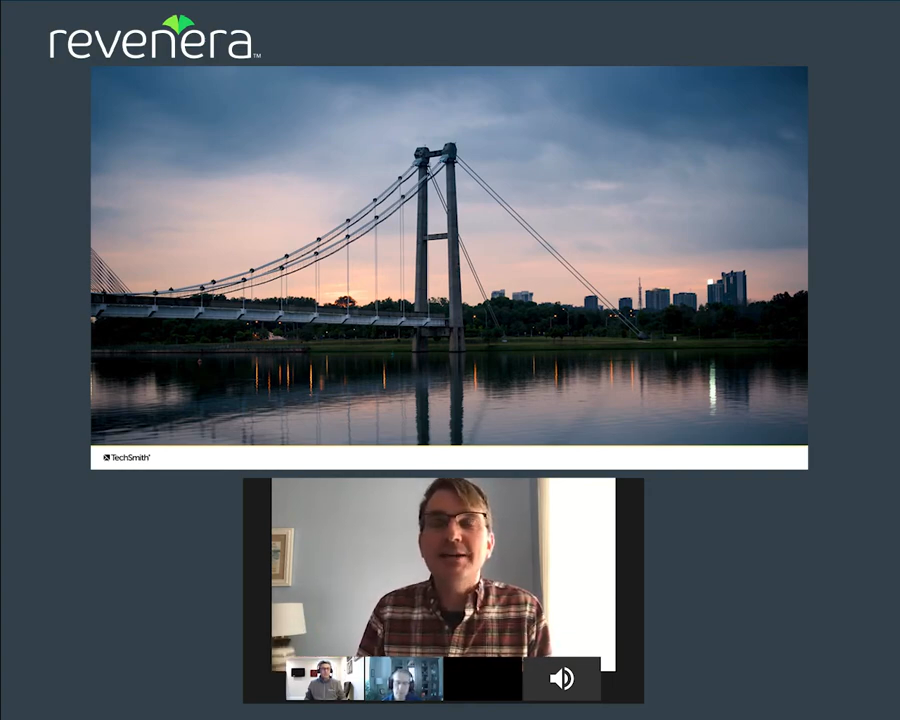Webinar
Turning Trial Users into Successful Customers
Discover how TechSmith and Revenera use data-driven onboarding to boost trial conversions and customer success.
Original Air Date: November, 2020
Overview
If you're a software producer looking to turn more trial users into loyal customers, this webinar is a must-watch.
Join Daniel Foster, Snagit Strategy Lead at TechSmith, and Victor DeMarines, VP of Product Management for Software Monetization at Revenera, as they dive into how data-driven onboarding and in-product messaging can dramatically improve trial conversion rates.
This session explores how TechSmith uses usage analytics and segmentation to deliver personalized onboarding experiences that connect users with product value faster. You'll learn how to identify "jobs to be done" from real user feedback, tailor onboarding based on usage behavior, and experiment with in-app messaging to guide users toward success. Discover how TechSmith increased engagement and conversion by aligning product experiences with user intent—without overwhelming them. Whether you're building B2B or B2C software, this webinar offers actionable insights into shortening time-to-value and boosting retention. If you're investing in product-led growth, this is your blueprint for smarter onboarding and monetization
Recap
Key Themes and Takeaways
Turning Trial Users into Successful Customers
The webinar explores how software producers can improve trial conversion rates by using data-driven onboarding strategies. Daniel Foster from TechSmith and Victor Marines from Revenera share how personalized in-product messaging and usage analytics can guide users toward realizing product value faster.
Experimentation During the Trial Period
TechSmith moved beyond pre-download marketing optimization to experiment within the trial experience itself. Using Revenera’s ReachOut functionality, they pushed tailored messages based on user behavior, enabling faster iteration and more impactful onboarding.
Software Usage Analytics and In-App Messaging
Usage analytics help software producers understand feature adoption and user behavior. The ReachOut tool allows for targeted in-app messaging, even in on-premise applications, helping improve user experience and drive engagement.
Time-to-Value and the “Half a Bridge” Analogy
Daniel Foster introduces a compelling metaphor: shipping features without helping users connect with their value is like building half a bridge. The goal is to shorten time-to-value during trials so users quickly see the benefit and are more likely to convert.
Identifying Jobs to Be Done Through User Reviews
Instead of guessing user intent, TechSmith analyzed G2 reviews to identify nine core “jobs to be done.” New trial users are asked to select their goal, which then informs personalized onboarding and messaging strategies. This segmentation is powered by Revenera’s usage analytics.
Tailoring Onboarding Based on User Segments
By mapping usage patterns to specific jobs to be done, TechSmith discovered meaningful differences in how users interact with Snagit. For example, users creating training content were more likely to use video features, guiding how onboarding content was prioritized.
Measuring Impact Through Controlled Experiments
TechSmith ran split tests using in-product banners to compare generic messaging with personalized onboarding tracks. The results showed a measurable lift in trial-to-paid conversions, validating the effectiveness of targeted messaging.
Content Format Preferences and Delivery Channels
Survey data revealed that users prefer video content and often start their learning journey via Google. This insight helped TechSmith prioritize video tutorials and optimize their delivery through both email and in-product channels.
Respectful Messaging Design
To avoid overwhelming users, TechSmith designed unobtrusive banners and gave users control over message types. They also used pop-ups sparingly, focusing on value-driven content like “What’s New” introductions.
Evolution of Usage Analytics at TechSmith
The webinar concludes with a look back at TechSmith’s journey—from basic usage questions to sophisticated segmentation and experimentation. Usage analytics now inform product decisions, feature prioritization, and customer education strategies.
Speakers

Daniel Foster
Director of Strategy, Monetization, Partnerships
TechSmith

Vic DeMarines
VP of Product Management for Software Monetization
Revenera

Michael Goff
Principal Product Marketer
Revenera
Frequently Asked Questions
Software producers can boost conversion rates by using data-driven onboarding strategies that personalize the user experience during trials. By segmenting users based on their goals and usage behavior, companies can deliver targeted in-app messages that guide users toward realizing product value faster. This approach helps users connect with relevant features and use cases, increasing the likelihood of purchase. Experimentation and analytics are key to refining these strategies over time.
Usage analytics tracks how users interact with software features, helping producers understand adoption patterns and identify friction points. This data is crucial for optimizing onboarding, improving product design, and tailoring messaging to user needs. It also enables segmentation and experimentation, which are essential for increasing engagement and conversion. Ultimately, usage analytics helps software companies deliver more value and drive monetization.
“Jobs to be done” refers to the specific goals users are trying to accomplish with a product. Identifying these jobs allows software producers to personalize onboarding experiences that align with user intent. By mapping usage data to these goals, companies can prioritize which features to introduce first, improving time-to-value and increasing user satisfaction. This approach leads to more effective onboarding and higher conversion rates.
In-app messaging allows software producers to deliver timely, relevant guidance directly within the product interface. When tailored to user behavior and goals, these messages help users discover valuable features and overcome obstacles. Compared to email, in-app messaging offers immediacy and context, making it a powerful tool for improving engagement during trials. It also supports experimentation to test which messages drive the best outcomes.
Time-to-value is the speed at which users realize the benefits of a product. Shortening this time is critical during trials, as users are evaluating whether the software meets their needs. By guiding users to high-impact features early, software producers can increase the likelihood of adoption and conversion. A faster time-to-value also improves user satisfaction and retention.
Experimentation allows producers to test different onboarding flows, messages, and content formats to see what drives the best results. Split testing in-product messaging, for example, can reveal which approaches lead to higher conversion rates. By continuously iterating based on usage data and feedback, companies can refine their onboarding strategies and improve outcomes. This data-driven approach is essential for scaling software monetization.
Video content is often the most preferred format for onboarding, especially when users are learning new technology. Surveys and analytics show that users frequently start with Google searches and engage most with video tutorials. Software producers should prioritize video-based onboarding materials that are aligned with user goals and delivered through both email and in-product channels. This improves engagement and helps users connect with product value faster.
Segmentation involves grouping users based on their goals, usage behavior, or experience level. This allows software producers to tailor onboarding messages and content to each group’s specific needs. For example, users creating training content may need guidance on video features, while others may benefit from image editing tips. Segmentation ensures that users receive relevant support, improving satisfaction and conversion.
Effective in-product messaging should be timely, relevant, and unobtrusive. Messages should guide users without overwhelming them, using minimal screen space and offering opt-out options. Software producers should categorize messages (e.g., helpful tips vs. promotional content) and allow users to control what they see. Respectful design builds trust and enhances the user experience during trials.
Usage analytics provides insights into which features are used most, which are underutilized, and how users interact with the product. This data helps software producers decide which features to invest in, retire, or redesign. It also supports targeted surveys to understand user motivations and pain points. By aligning product development with actual user behavior, companies can deliver more value and improve monetization outcomes.
Resources
Case Study
a.i. solutions® Launch Flexible Licensing to Accelerate Growth
See how they saved two years in development time, reduced support tickets by 500%, and continue to grow.
Industry Report
Forrester Total Economic Impact Study
Learn More About 426% ROI and Operational Efficiencies Enabled by Revenera
Case Study
Toon Boom Drives Double-Digit Growth with Streamlined Monetization Processes
The implementation of the new licensing and entitlement management solution resulted in several tangible benefits for Toon Boom.
Want to learn more?
See how Revenera's Software Monetization platform can help you take products to market fast, unlock the value of your IP and accelerate revenue growth.
